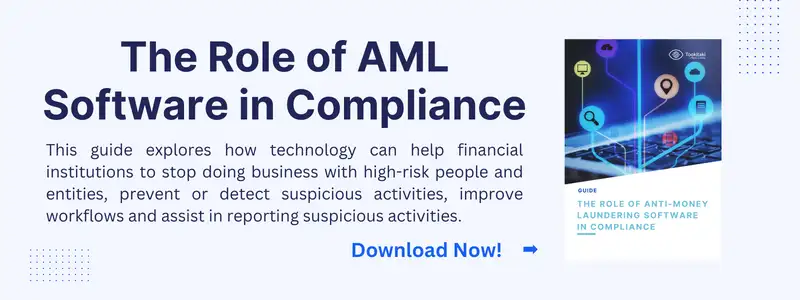How AML Technology is Transforming Financial Crime Prevention
In an era where financial crimes are becoming increasingly sophisticated, traditional methods of Anti-Money Laundering (AML) are no longer sufficient. Financial institutions need to embrace advanced technology to keep pace with the evolving tactics of criminals. This blog explores the pivotal role that AML technology plays in modern compliance, highlighting key innovations like artificial intelligence, cloud computing, and blockchain. We also delve into Tookitaki’s groundbreaking solutions that are setting new standards in the fight against financial crime.
The Evolution of AML Technology
Early Days of AML Compliance
In the early days, Anti-Money Laundering (AML) efforts were largely manual. Financial institutions relied on paper-based records and human oversight to detect and prevent money laundering activities. While these methods were a good start, they had significant limitations. The sheer volume of transactions and the increasing sophistication of financial criminals made it difficult for traditional methods to keep up. This often led to missed red flags, allowing illicit activities to slip through the cracks.
The Rise of Technology in AML
As technology advanced, so did the tools available for AML compliance. The shift from manual processes to automated systems marked a significant improvement in the fight against financial crime. Technologies like Artificial Intelligence (AI), Machine Learning (ML), and blockchain began to play a crucial role in identifying suspicious activities.
These advancements have enabled financial institutions to process vast amounts of data quickly and accurately, making it easier to spot anomalies and potential risks. The rise of AML technology has not only improved efficiency but also significantly reduced the likelihood of human error.
Key AML Technologies Shaping the Future
Artificial Intelligence and Machine Learning
Artificial Intelligence (AI) and Machine Learning (ML) have become game-changers in the world of AML. These technologies can analyze vast amounts of data in real-time, detecting patterns and anomalies that might be missed by human analysts. AI and ML enhance the ability to identify complex money laundering schemes by learning from historical data and continuously improving detection models. This means that as financial criminals develop new tactics, AI-driven AML solutions can adapt and stay one step ahead. Examples of AI in AML include the automation of transaction monitoring and the reduction of false positives, which allows compliance teams to focus on high-priority alerts.
Cloud Computing for AML
Cloud computing offers unparalleled advantages in the realm of AML, especially when it comes to managing large datasets. By leveraging cloud technology, financial institutions can store and process enormous volumes of transaction data with ease. The scalability of cloud platforms allows institutions to handle spikes in data processing needs without the need for significant upfront investment in infrastructure. Additionally, cloud-based AML systems are accessible from anywhere, ensuring that compliance teams can operate efficiently even in remote work environments. This flexibility and efficiency make cloud computing an essential component of modern AML strategies.
Blockchain Technology
Blockchain technology is another revolutionary tool in AML. It provides a transparent and immutable ledger of transactions, which makes it easier to trace the flow of funds. This traceability is particularly useful in identifying and tracking suspicious activities across borders. Blockchain's decentralized nature also reduces the risk of fraud, as no single entity has control over the entire transaction history. Financial institutions are increasingly exploring blockchain for AML purposes, particularly in areas like cross-border payments, where transparency and security are paramount.
Advanced Transaction Monitoring Systems
Transaction monitoring is a cornerstone of effective AML practices, and advanced systems are taking this to the next level. These systems use real-time analytics to monitor transactions as they occur, enabling immediate detection of potentially suspicious activities. Unlike traditional methods that might review transactions after the fact, real-time monitoring allows for instant response to risks. This proactive approach helps prevent money laundering before it can escalate. Case studies have shown that financial institutions using advanced transaction monitoring systems experience fewer compliance breaches and are better equipped to manage regulatory scrutiny.
Challenges and Future Trends in AML Technology
Addressing False Positives
One of the most persistent challenges in AML technology is the issue of false positives. These occur when legitimate transactions are flagged as suspicious, leading to unnecessary investigations and increased operational costs. False positives can overwhelm compliance teams, diverting attention from genuine threats. To tackle this, Tookitaki employs advanced AI-driven techniques that significantly reduce the number of false positives. By learning from past data and continuously refining its algorithms, Tookitaki’s solutions ensure that alerts are more accurate, allowing compliance teams to focus on the most critical cases. This not only improves efficiency but also enhances the overall effectiveness of AML efforts.
Regulatory Compliance and Technology
As financial crime tactics evolve, so do the regulations that govern AML practices. Keeping up with these changing regulations can be a daunting task for financial institutions. This is where technology plays a crucial role. Modern AML solutions, like those offered by Tookitaki, are designed to be adaptable, ensuring that they can quickly incorporate new regulatory requirements. The AFC Ecosystem, for example, continuously updates its compliance frameworks based on the latest regulatory changes, ensuring that institutions remain compliant without having to overhaul their systems. This ability to stay ahead of regulatory demands is a key advantage of using advanced AML technology.
The Future of AML Technology
Looking ahead, the future of AML technology is set to be shaped by several emerging trends. One of the most significant is the increased use of artificial intelligence and machine learning, not just for detection but also for predicting and preventing financial crimes before they occur. Additionally, technologies like blockchain and advanced analytics will likely become more integrated into AML systems, offering even greater transparency and efficiency. As financial criminals continue to develop more sophisticated methods, the need for innovative and adaptive AML technologies will only grow. Institutions that embrace these technologies will be better equipped to stay ahead of threats and maintain compliance in an increasingly complex landscape.
The Role of Tookitaki in AML Technology Innovation
FinCense: Tookitaki’s End-to-End Compliance Platform
FinCense is a key innovation from Tookitaki, offering an end-to-end compliance solution that integrates seamlessly with the AFC Ecosystem. FinCense is designed to cover every aspect of AML and fraud prevention, from customer onboarding and transaction monitoring to name screening and alert management. What sets FinCense apart is its use of AI and Machine Learning to enhance detection accuracy and reduce false positives. The platform’s ability to quickly operationalize new typologies from the AFC Ecosystem ensures that financial institutions are always equipped to deal with the latest threats. With FinCense, compliance becomes more efficient, less error-prone, and more aligned with the ever-evolving regulatory landscape.
The Anti-Financial Crime (AFC) Ecosystem
Tookitaki has taken a groundbreaking approach to AML technology with its Anti-Financial Crime (AFC) Ecosystem. This platform is not just a tool but a collaborative community where financial institutions, regulators, and industry experts come together to share insights and strategies. The AFC Ecosystem leverages collective intelligence to continuously update and refine its AML capabilities. This means that as new money laundering tactics emerge, the ecosystem adapts in real time, providing financial institutions with the most current and effective tools to combat financial crime. By joining this ecosystem, institutions benefit from the shared knowledge of a global network, significantly enhancing their ability to detect and prevent financial crimes.
Why Financial Institutions Must Embrace AML Technology
In today’s fast-evolving financial landscape, staying ahead of financial criminals is not just an option—it’s a necessity. The complexity and sophistication of modern money laundering schemes require equally advanced solutions. AML technology, powered by artificial intelligence, machine learning, and other cutting-edge tools, provides financial institutions with the means to detect, prevent, and respond to financial crimes more effectively than ever before.
By adopting advanced AML solutions like Tookitaki’s AFC Ecosystem and FinCense platform, financial institutions can ensure they remain compliant with ever-changing regulations while significantly enhancing their ability to combat financial crime. The future of AML lies in technology, and those who invest in it today will be better prepared for the challenges of tomorrow.
Explore how Tookitaki’s AFC Ecosystem and FinCense platform can revolutionize your institution’s approach to AML compliance. Join the growing community of financial institutions that are leveraging collective intelligence and cutting-edge technology to stay ahead of financial crime.
Anti-Financial Crime Compliance with Tookitaki?





